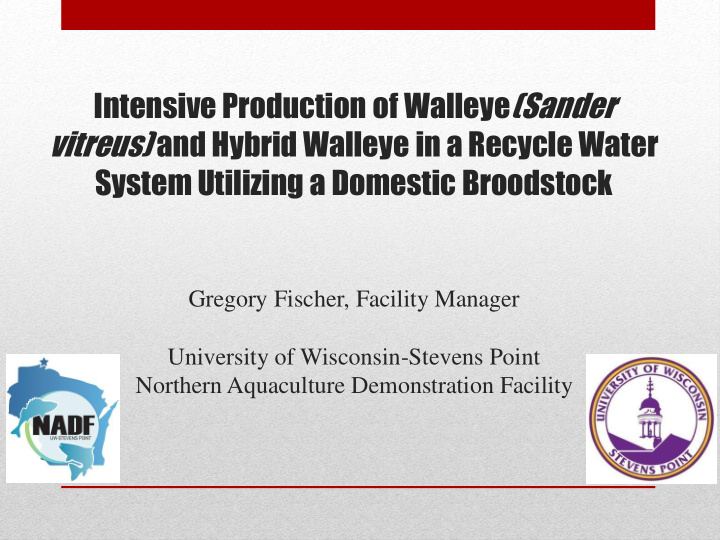



Intensive Production of Walleye (Sander vitreus) and Hybrid Walleye in a Recycle Water System Utilizing a Domestic Broodstock Gregory Fischer, Facility Manager University of Wisconsin-Stevens Point Northern Aquaculture Demonstration Facility
Objectives The UWSP-Northern Aquaculture Demonstration Facility (Bayfield, WI) conducted a three year pilot project to evaluate and demonstrate commercially available new technologies for producing purebred and hybrid walleye for stocking and food fish. The project consisted of different areas including: Intensive production and seasonal advancement of captive walleye and sauger broodstock. Production of large walleye (>300mm)(12inch) on commercial feed for NR stocking. Production of hybrid walleye to food market size(454g)(1.0 pd) using intensive rearing and recirculation systems.
Captive Broodstock Winter period Coldbanking
Seasonal Advancement of Spawning Hormone Injection Method Manipulate water temperature Human Chorionic Gonadotropin (hCG)Hormone 2 injections: 3-5 days apart Females 500 IU/Kg Males 350 IU/Kg
Out of Season Spawning Photoperiod and Water Temperature Manipulation Manipulate Water Temperature and Photoperiod Overhead Lighting, Water Chiller and Boiler Start August- set eggs- Early winter spawn(Feb) Extend spawn into June
Materials and Methods Incubation
Materials and Methods Experimental Tank Setup for Phase I-II Intensive Rearing • 240 L (60 gal) round tanks • Sidewalls painted black • Gray bottom • Adjustable lighting • Directional flow-thru 20ºC(70ºF) water (2-8 lpm) • Clay(old mine #4)(50-80 NTU) • 24 hr feeders • Surface spray • Removable screens • Daily cleaning system
Water inflow pipe Feeder Surface Directional water flow spray Center screen
Otohime fry feed Nelson Silvercup 200 -1400 m walleye grower 1.0mm
Materials and Methods Recycle System Used For Phase III-IV Intensive Growout RAS Parameters: • 53,000 L water capacity • 33 m³ tank culture space • Fluidized sand biofilter • Drum Filter • Dual drain circular tanks • Oxygen cone • In sump electric heater • 23ºC (74ºF)Water temp.
Results Overall Survival Percentages Intensive Rearing 100 90 0-38 mm Phase III 80 38-51 mm 70 Phase II % survival 51-102 mm 60 Phase I 50 102-152 mm 40 >90% 152-239 mm 48% 48% 30 20 10 0 Phase and fish length
Walleye/Hybrid Walleye: Cannibalism • Starts immediately • Unobserved mortality • Can account for low survival rate in ponds and in indoor tanks
Results Phase 1- Fry Culture Unobserved Phase I Fry Mortality ie. Cannibilism 60 51% 50 Overall mortality % 40 33% 30 20 10 Low Density High Density 0
Results Growth Rates Hybrid Walleye vs P urebred Walleye Growth in Weight 450 Phase II Phase III Phase I 400 Growout in Recycle System Early Lifestage 350 Rearing 300 250 Grams S E -10 200 S E -09 WE -10 150 WE -09 100 50 0 20 29 37 52 58 64 67 73 85 91 98 105 116 127 129 142 156 159 170 173 187 197 201 222 228 251 262 288 317 346 366 April June Aug Nov March Days P os t Hatc h
1 year old Hybrid Walleye (1.0kg)
Results Extended Growout Growth Rates Weight gain of Hybrid Walleye R eared in R ecycle S ys tem at 23 C 700 600 Growout phase III-IV DGR =1.4 g/day 500 400 Grams 300 Fingerling phase II 200 DGR =0.5 g/day 100 0 50 66 95 114 159 192 235 270 310 370 430 490 560 Days P ost Hatch
Results Hybrid Walleye Feed Rates and Conversion Ratio 20 20 18 16 15 14 12 10 7.5 8 7 6 4 4 2 2 2 TBWFD(%) 0 1.6 1 FC 2 3 4 Growth Phase
Conclusion Walleye and hybrid walleye can be successfully reared indoors utilizing captive broodstock, early advanced spawning, incubation, and rearing techniques Processing yields of >50% and initial marketing studies indicate good aquaculture potential and high demand for hybrid walleye as food fish.
Acknowledgements We would like to thank Alan Johnson at the Rathbun Fisheries Research Center in Iowa for all his assistance and guidance. We would also like to acknowledge the efforts of NADF technicians Lance Bresette, Nate Martin. Dr. Chris Hartleb (Director) and Jim Held (Extension) have also provided assistance and guidance throughout this project. This project was supported by an Agricultural Development & Diversification grant through the Wisconsin Department of Agriculture, Trade and Consumer Protection. Mention of trade name, proprietary product, or specific equipment does not constitute a guarantee or warranty and does not imply approval to the exclusion of other products that may be suitable. QUESTIONS?????????????? http://aquaculture.uwsp.edu gfischer@uwsp.edu
Recommend
More recommend